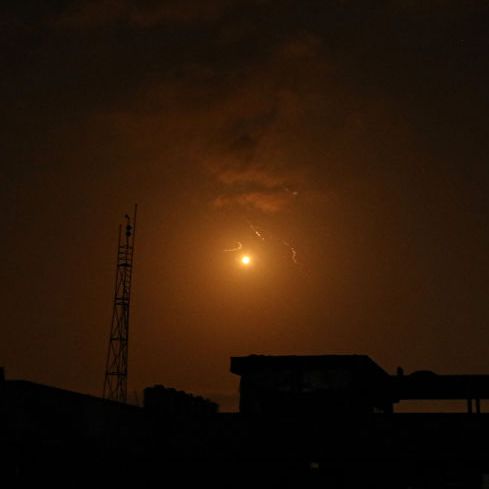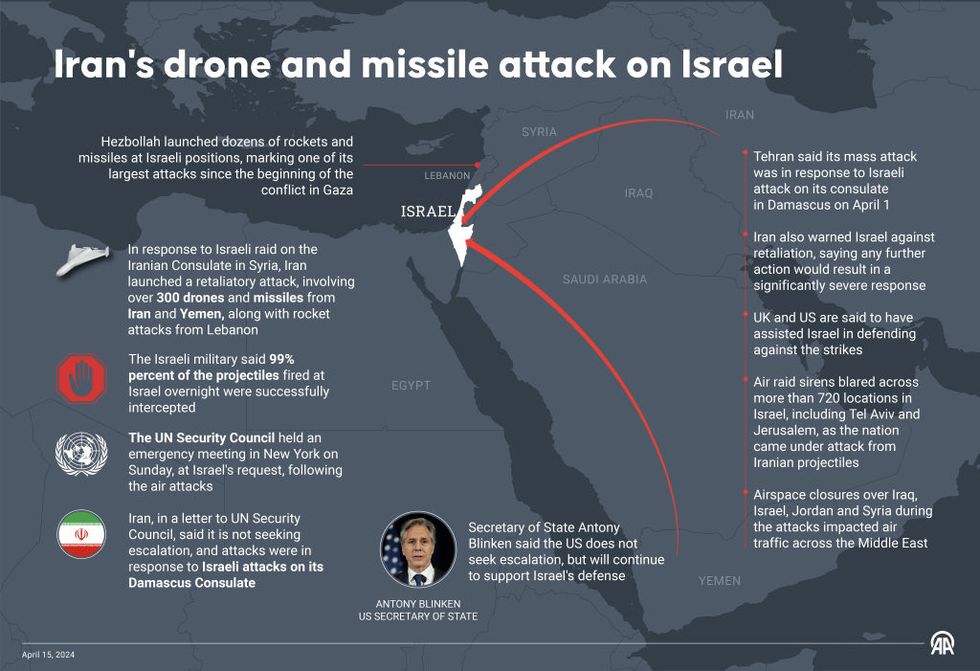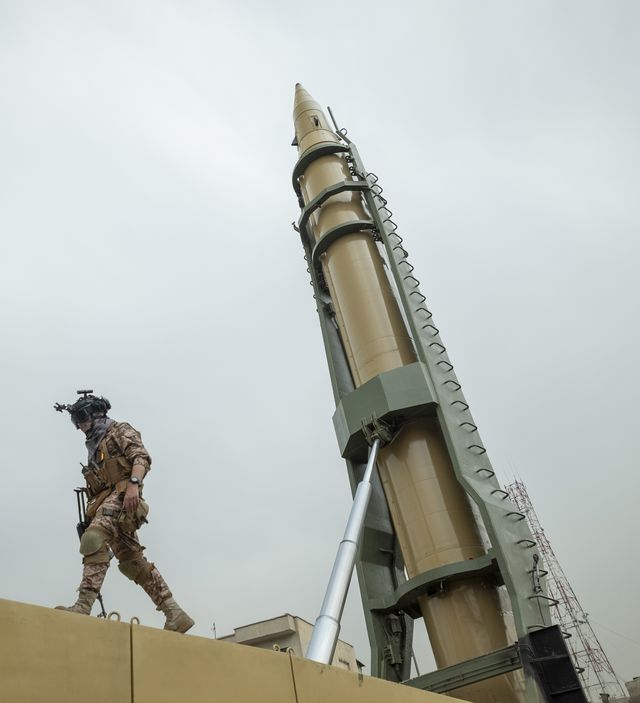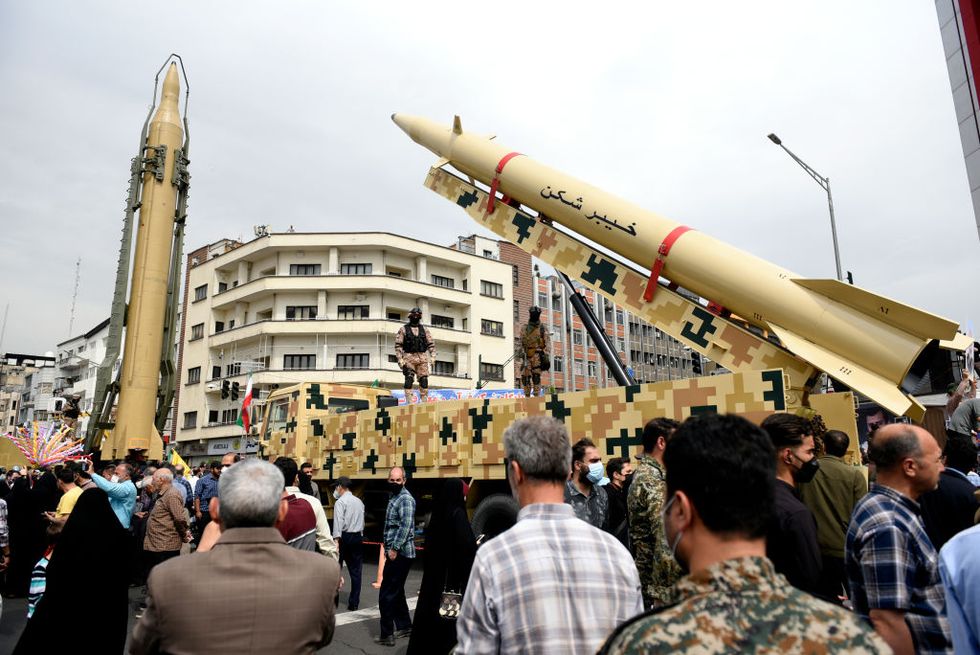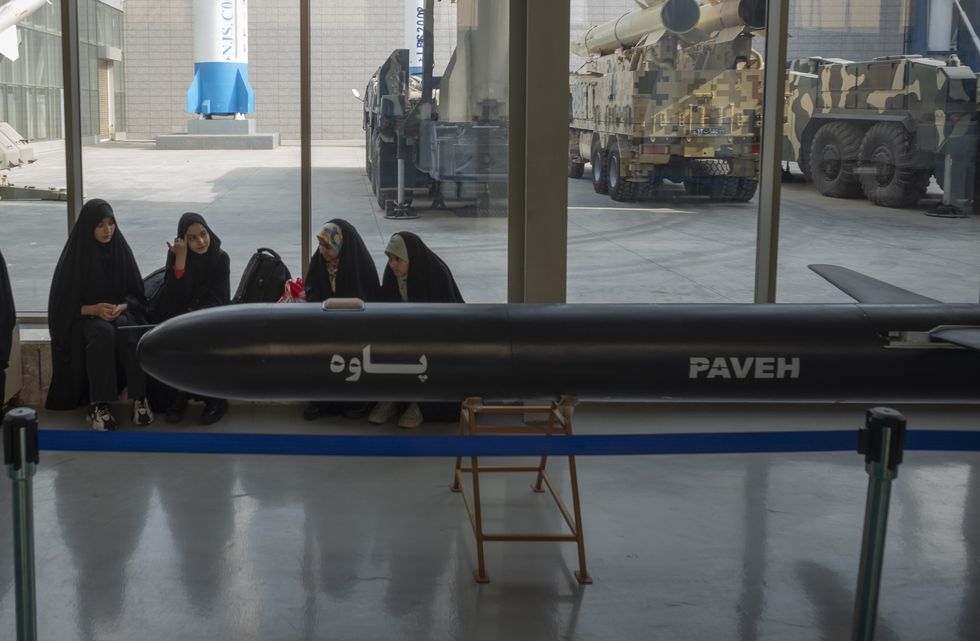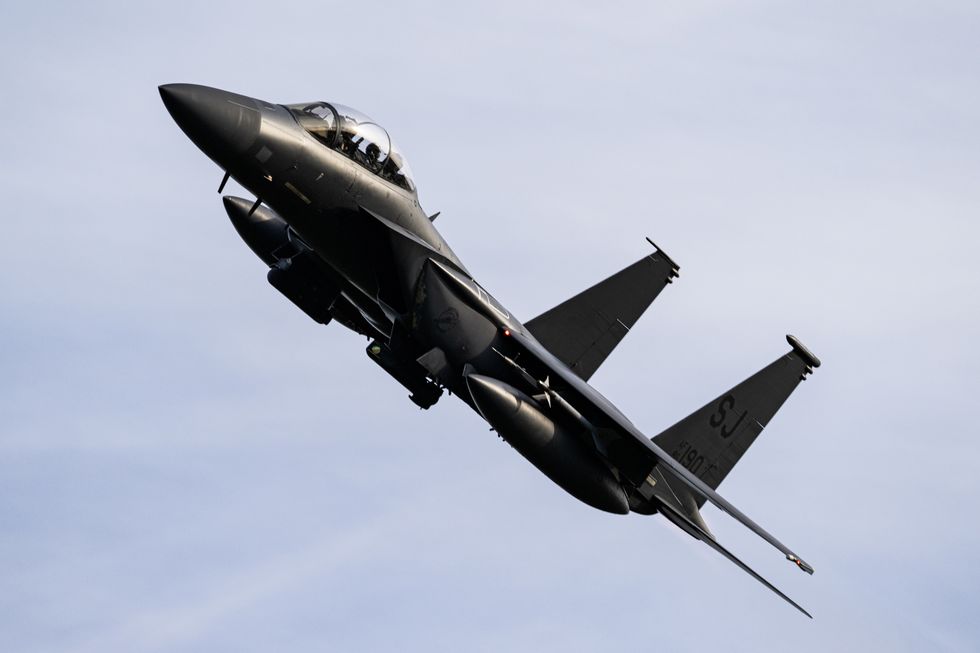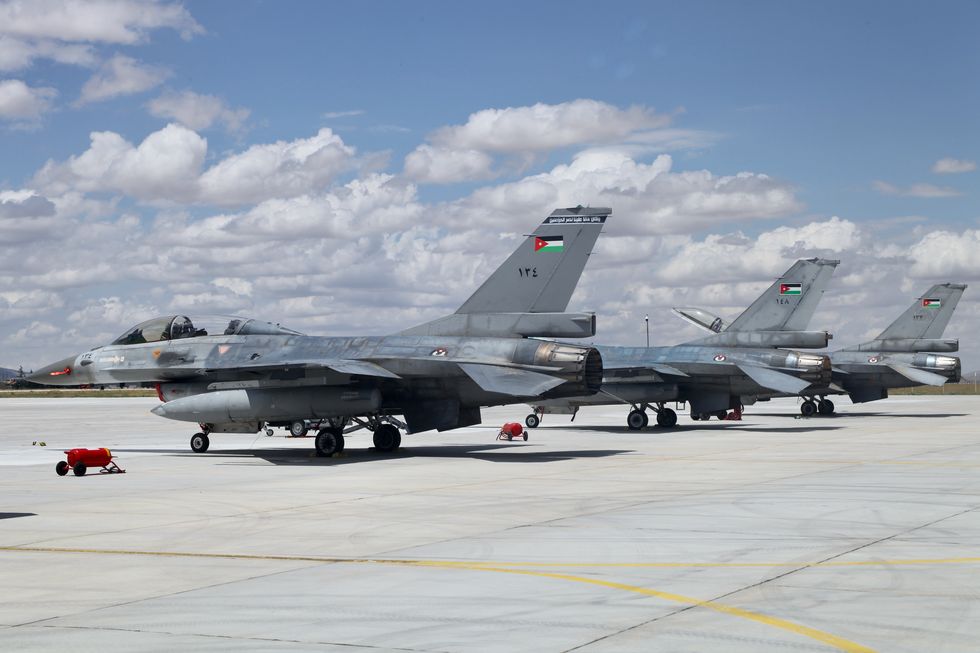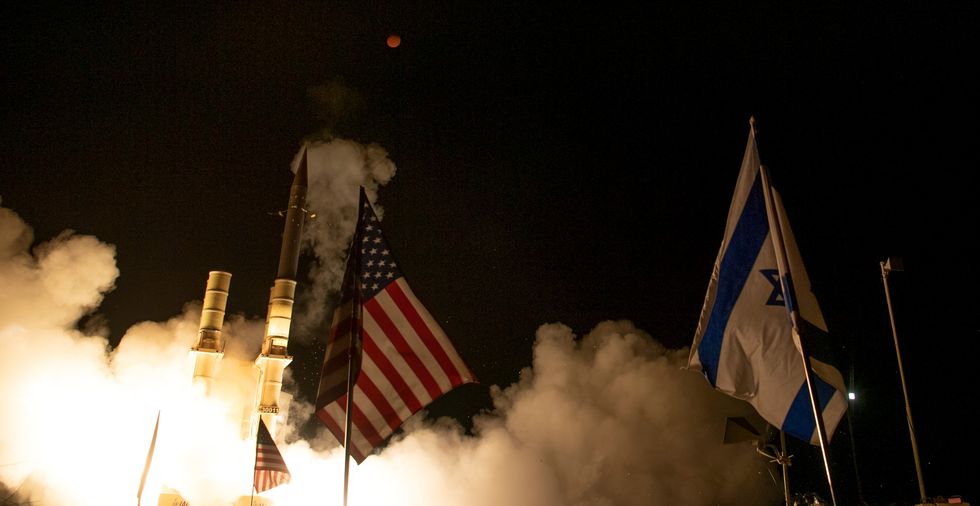On the evening of April 13 into the morning of April 14, the night sky above the Middle East was rent by streaks of light and explosions as an unprecedented air and space battle raged. First, roughly 170 kamikaze drones stuffed with explosive payloads—mostly Shahed 136s, already used extensively by Russia to bombard Ukraine—lifted off from Iran, and upon ditching their rocket-assisted takeoff boosters, proceeded towards Israel propelled by their buzzing piston engines at car-on-the-highway speeds.
As the drones neared the end of their roughly nine-hour journey, the launch flashes of dozens of rocket boosters in Yemen and Iran set the infrared sensors on SBIRS early-warning satellites aglow. Around 120 ballistic missiles rocketed upwards before arcing towards Israel at supersonic speed.
Rounding out the mixed barrage of very fast and very slow death machines were 30 cruise missiles that streaked towards Israel at subsonic velocity and significantly lower altitudes, posing a more insidious threat than the fast but obvious ballistic missiles and ponderous drones.
Meanwhile, Iran-allied Houthi rebels in Yemen (even further away from Israel) contributed additional missiles and drones approaching from the south.
Even as this orchestra of destruction converged on Israel, a sophisticated (and highly expensive) multinational air defense apparatus leapt into action to combat it.
The run-up to Iran’s attack on Israel
Despite being separated by over 600 miles and multiple international borders, Israel and Iran have violently (and only somewhat covertly) clashed ever since the Iranian Revolution. Iran has armed and trained various factions combatting Israel and orchestrated sabotage and terrorist attacks, while Israel has bombed Iranian forces in Syria and assassinated Iranian nuclear scientists.
But on April 1st, 2024, an Israeli airstrike blew up a consulate building adjacent to the Iranian embassy in Syria, killing eight officers in Irans’ Revolutionary Guard Corps (including two generals). Afterwards, Iran’s leadership made clear that they saw the direct attack on an embassy compound as going too far—and intended to exact payback.
In truth, Iran’s intentions for the strike it codenamed True Promise appear to have been mixed. It was clear that the country’s leaders believed they had to showily retaliate to maintain domestic and/or international credibility. But they also don’t appear to have wanted the strike to be so deadly as to trigger a wider and potentially protracted war with Israel and, possibly, the U.S. Two days prior to the strike, Iran forewarned diplomats of Saudi Arabia, Iraq and the United Arab Emirates of the imminent attack that would fly over their air space, surely knowing the word would be relayed to the U.S. and Israel.
This gave the U.S. and other Israeli allies time to deploy additional air defenses to the region. Hours prior to the strike, the Israeli government canceled leaves for all military personnel, shifted its aircraft, closed Israeli airspace and turned off GPS access to prevent its use for drone/missile targeting.
Perhaps Iran hoped for a repeat of its much smaller scale 2020 missile strike on U.S. bases in Iraq, made in retaliation for the U.S. assassination of a prominent general. Though lacking ballistic missile defenses, early warning sensors gave U.S. troops time to shelter underground when the missiles hit, resulting in 0 fatalities (though many U.S. personnel did suffer Traumatic Brain Injuries). The lack of deaths likely kept the U.S. from retaliating in kind with strikes on Iran.
But even with Iran intentionally relinquishing the benefit of surprise, the roughly 320-350 munitions launched by Iran on April 13 were no symbolic pinprick. Rather, they made up a ballistic missile and drone attack of unprecedent scale, mustering more than 85 tons of high explosive warheads. Stopping all of those flying weapons before they reached their target would prove a challenge.
What weapons did Iran use for its April 13 strike?
The primary drone deployed by Iran was the long-range Shahed-136 kamikaze drones—a type Russia began important from Iran in 2022, and has extensively used against Ukrainian cities. Iran was likely seeking to overwhelm and exhaust Israeli defenses with cheap but still dangerous drones, creating chaotic conditions it hoped would allow deadlier cruise and ballistic missiles to evade interception. Iran employed a similar drone/missile team-up on a smaller-scale for its infamous Aramco oil field attack in 2019.
More commonly used against fixed targets and cruising at just 75 miles per hour, the Shaheds are estimated to cost between $20,000 and $40,000 apiece, making them much cheaper than virtually any missile-based anti-aircraft weapon.
Some reports claim that Iran also employed some Shahed-238s—a jet-powered evolution of the 136 that flies at speeds exceeding 310 miles per hour.
In terms of ballistic missiles, wreckage suggests that Iran used at least some of its Emad medium-range ballistic missiles, which each have a range of 1050+ miles. These liquid fueled rockets released a maneuverable reentry vehicle (MARV) that can adjust course during the terminal plunge to improve accuracy—including potential to lock-on to naval targets using an infrared seeker.
Launch footage released by Iran also suggests the use of three other types of MRBMs.
The 6-ton Kheiber Shekan (AKA Khorramshar-4) saw its combat debut targeting rebels in Idlib, Syria in January of 2024. Its name, “Destroyer of Kheibar’, refers to a fort captured from Jewish defenders in year 628. Made of weight-saving composites, Kheiber is estimated to have an effective range exceeding 900 miles and its MARV suposedly achieves a hypersonic (Mach 5) terminal velocity. Fins on the weapon allegedly aid it in maneuvering to avoid interception and improve precision.
The Dezful, meanwhile, has shorter range of 620 miles but is said to be highly precise (average error within 5 meters of targets), and can achieve Mach 7 speeds.
There is also footage of Ghadr-110 missiles being launched. This weapon comes in variants with ranges of 839, 1025 and 1219 miles, and is boosted by liquid-fuel first stage rocket and solid-fuel second stage booster.
Iran’s long-range Soumar cruise missile family is derived from the Soviet Kh-55 missile. Per Iranian state sources, the variant used in April of 2024 is called the Paveh-351. Distinguished by both its turbojet engine and pop-out wings on the upper fuselage, Paveh reportedly boasts a range of 1,050 miles and a typical flight altitude of 50 meters.
The Iranian weapons were targeted primarily at Nevatim Airbase (home of the IAF’s F-35I stealth fighters), and a listening post on Mount Hermon. Other targets included downtown Tel Aviv and the Dimona nuclear reactor. Iran had employed Kheiber-Shekan, Emad, and Ghadr-110 missiles for a mock strike on an Israeli airbase just two months earlier.
There are also indications that a substantial number of Iranian missiles failed at launch or crashed while transiting to target over Iran, Iraq, and Jordan. An Iranian school was struck by a faulty missile, and another is known to have exploded at launch (possibly causing casualties). A U.S. military source told The Intercept that American intelligence estimated 50% of the Iranian weapons “…failed upon launch or in flight due to technical issues.”
Missiles, drones and jets battle in the clouds-and in space
Long-range radars afforded relatively good visibility of the approaching armada of missiles and one-way drones as they streaked westward towards Israel over the airspace of Iraq and Jordan, or northward from Yemen over Saudi Arabia and the Red Sea.
Saudi and Emirati early warning radars reportedly forwarded real time tracking data to a U.S. command center in Qatar which was used to forewarn ground defenses and orchestrate an air defense gauntlet that would destroy most of the attacking force before it could reach Israeli airspace.
U.S. Air Force F-15E Strike Eagle fighters reportedly destroyed over 70 of the pokey kamikaze drones. Pilots from the service’s 335th and 494th Fighter Squadrons deployed to Al Azraq airbase in Jordan were commended by President Biden for their actions that evening.
Navy F/A-18 Super Hornet pilots from the carrier Dwight D. Eisenhower were also reportedly active, and U.S. strikes preemptively destroyed on the ground in Yemen a Houthi vehicle-mounted ballistic missile and seven kamikaze drones while they were preparing to launch.
Both the Royal Jordanian Air Force and four two-seat Rafale-B fighters from France’s 4th Fighter Wing based at Prince Hassan airbase also reportedly engaged drones and missiles flying over Jordanian airspace. The RJAF is equipped with F-16A/B jets and MIM-23B I-Hawk surface-to-air missiles, and allegedly downed 20% of the Iranian drones (implying around 34.)
British Royal Air Force Typhoon fighters based in Cyprus also downed “a number of drones” (per Prime Minister Sunak) while flying over Iraqi and Syrian airspace.
Roving Israeli F-35 stealth fighters, F-15s, and F-16s scored additional kills, claiming the destruction of 25 of the 30 detected cruise missiles, as well as numerous drones using both short-range Python-5 and AIM-9L heat-seeking missiles and older, radar-guided AIM-7 Sparrow medium-range air-to-air missiles. They were assisted by Israel’s Gulfstream G550 Airborne Early Warning aircraft.
Meanwhile, two U.S. Navy Arleigh Burke-class destroyers in the Red Sea—already battle hardened from battling months of Houthi drone and missile attacks—fought their own unprecedented battle. The destroyers Carney downed three medium-range ballistic missiles, and Arleigh Burke downed a fourth. The ships may have also downed two additional missiles.
These actions involved the first confirmed operational use of powerful RIM-161 SM-3 interceptor missiles, designed to reliably destroy medium and intermediate-range ballistic missiles (and possibly intercontinental range missiles too) while arcing high in space in their midcourse flight phase. Reportedly “4 to 7” SM-3s were launched, each costing a whopping $11.5 million per a 2021 unit pricing.
The SM-3 weighs 1.5 tons, and its three-stage rocket boosters allow it to achieve ridiculous Mach 13 speeds (roughly 2.5 miles per second) before releasing a ‘kill vehicle’ (EKV) with its own infrared seeker and maneuvering thrusters to complete a ‘hit-to-kill’ kinetic intercept.
A U.S. Army Patriot air defense battery in Erbil, Iraq claimed an additional ballistic missile kill.
However, the majority of the other ballistic missiles were likely downed by Israel’s sophisticated, multi-layered integrated air defense systems—notably including its Arrow-2 and Arrow-3 ballistic missile interceptors (the latter of which saw its combat debut on October 31), as well as its medium-to-long range David’s Sling surface-to-air batteries. The intercept of one Iranian missile while outside the Earth’s atmosphere was captured on camera, resulting in a blue-tinted donut ring blast.
Arrow 3s allegedly accounted for 110 of the 130 ballistic missiles, per the Israeli newspaper Maariv. The extent of the contribution by Israel’s shorter-range Iron Dome and David’s Sling batteries remains unclear.
Aftermath of Iran's strike on Israel
When the dust had cleared, not a single drone made it into Israeli airspace. Nor did any cruise missile make it to target. But nine ballistic missiles did reportedly strike two Israeli airbases.
Five of these damaged a taxiway at Nevatim airbase, a nearby C-130E cargo plane (retired and non-flyable), and several empty hangars, but didn’t impede the base’s continued operational use. Meanwhile, Ramon Airbase in the Negev desert (which houses F-16I fighters and AH-64D Apaches) was also assailed by 4 missiles apparently causing negligible damage.
The attack’s sole serious casualty was a 7-year-old Bedouin girl gravely injured in her home by fragments from an intercepted missile near Nevatim. Another 31 persons suffered minor injuries or panic attacks.
The success of the combined air defense effort, however, had a difficult flipside—costs. A retired Israeli general estimated that the munitions expended cost the equivalent to $1.5 billion, before even taking into account fuel and other operating costs of the manned jets. Another Israeli estimate puts the price at $550 million.
Arrow 3 interceptors are priced at $3.5 million per shot, and David’s Slings at $1 million each. Shorter-range air-to-air missiles typically cost in the low-to-mid hundreds of thousands of dollars. Iran’s ballistic missiles likely cost in the mid hundreds of thousands of dollars or more.
If Iran can build a sufficiently deep missile and drone inventory to sustain such salvos, it would risk exhausting the more expensive weapons used to contain them. Exactly what fraction of Iran’s MRBM arsenal—and what percentage of Israel’s defensive missiles—was expended in the April 13/14 attack remains a pertinent X factors when judging which side could outlast the other in a sustained war of missile attrition.
On the other hand, the 0% penetration rate of Iran’s drones and cruise missiles and apparent 7% penetration rate of its ballistic missiles cast doubt that Iran could reliably deliver a nuclear attack past Israel’s air defense systems without building a very large number of nuclear warheads.
However, some also argue that the attack might have inflicted considerably more damage had Israel not been aided by the U.S., Jordan, France, Saudi Arabia, the UAE, and the United Kingdom, and been extensively forewarned of the attack.
The outcome of the clash has been spun as a victory by both sides, though this mostly bloodless fracas has highlighted strategic dilemmas facing both countries. It has also dramatically illustrated how improved, long-range missiles and drones are transforming 21st century warfare by making large-scale strategic attacks more viable than before. Likewise, effectively and sustainably defeating missile and drone attacks is growing more important than ever.
Such complex missile and drone raids have played out daily in the skies over Ukraine since 2022, and one would expect even larger scale drone and missile strikes in the horrible event of a China-Taiwan conflict—particularly as the distance across the Taiwan strait is much shorter than that between Iran and Israel, and China possesses a more extensive and capable arsenal than Iran.
Sébastien Roblin has written on the technical, historical, and political aspects of international security and conflict for publications including 19FortyFive, The National Interest, MSNBC, Forbes.com, Inside Unmanned Systems and War is Boring. He holds a Master’s degree from Georgetown University and served with the Peace Corps in China. You can follow his articles on Twitter.
